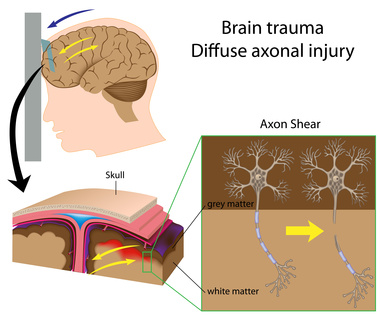 Thanks to a patent granted on March 6, 2012, there’s new hope for victims of traumatic head injuries. This innovative treatment method targets the neuro-inflammation caused by severe head trauma. Here’s more information about this promising new biochemical invention:
Thanks to a patent granted on March 6, 2012, there’s new hope for victims of traumatic head injuries. This innovative treatment method targets the neuro-inflammation caused by severe head trauma. Here’s more information about this promising new biochemical invention:
What is Traumatic Brain Injury?
First, it’s important to understand this type of injury. Traumatic brain injury is damage to the brain caused by an extreme blow to the head. Although this type of injury can be caused by a fall or an assault, the most common cause is car or bike accidents. The primary damage occurs at the time of the impact and can include contusions, lacerations and hemorrhaging. However, the most severe damage is often secondary. After the impact, the victim may lose consciousness for an extended period of time, experience restricted oxygen supply to the brain, lose blood flow to their brain or suffer from severe infections and inflammation. In most cases, traumatic brain injury is permanent and severely dehabilitating even with the best medical care.
A New Treatment Method
Treating any type of brain injury or infection can be challenging due to the blood/brain barrier. Intended to protect the human brain from common viruses and bacteria, this life-saving mechanism can act against the victim when medication must reach the brain quickly. This new treatment method fuses the medication with a carrier molecule to allow it to easily cross the barrier and reach its target.
Source: United States Patent 8,128,920, Sagot , et al. March 6, 2012
What Does This Mean for You?
A patent approval is a wonderful first step, but it may be years before this treatment method is available to accident victims. Before any new drug or treatment method is approved for use on humans, it must pass through a rigorous testing procedure to make sure its benefits outweigh any serious side effects. In many cases, the trial period finds some form of defect that prevents the new patented invention from going further. At this point, it’s too early to say what will happen to this promising new treatment method. In the meantime, drivers should be especially careful to avoid car accidents that could result in a traumatic brain injury.
What If Someone I Care About Has Experienced a Traumatic Brain Injury?
If the unthinkable happens, your loved one may be facing an uphill battle. Most traumatic brain injury victims experience a significant amount of cognitive impairment. This means they may no longer be able to work, to care for themselves or handle their personal matters. In other words, this is a time when you or another family member may have to step in to help them pick up the pieces. While you can rely on the medical experts to do everything they can to minimize the damage, you can’t trust the insurance companies to treat a traumatic brain injury victim fairly. They know that this type of injury deserves a lifetime of support and care, and this doesn’t work well with their bottom line. Instead of trying to negotiate a fair settlement on your own, use the help of an experienced personal injury attorney to recover the compensation that your loved one needs and deserves.
In the United States, about 1.7 million people will sustain a traumatic brain injury this year, and about 30.5 percent of all deaths caused by an injury will involve a traumatic brain injury. In the year 2000 alone, traumatic brain injuries cost the United States about $76.5 billion in medical expenses and lost productivity. When these statistics are considered, it’s clear that new treatment methods for traumatic brain injury can make a life-altering difference to many.
